yeovil trades & traders
John Chaffin & SOns
Photographers of Hendford
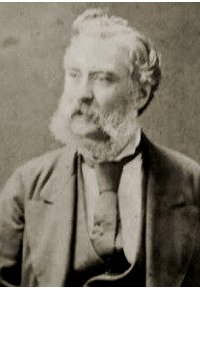 John
Cox Chaffin was
born in Yeovil 1826 and
baptised in
St John's church on 11
October 1826. He
was the second son of
Kingston baker
George
Chaffin (b1807)
and Ann née Cox
(1807-1860). He
had an older
brother, George
(1825-1890). Ann
was the eldest
daughter of
auctioneer John
Cox of Yeovil,
who was for
forty years the
Sheriff's
Officer for the
county of
Somerset.
John
Cox Chaffin was
born in Yeovil 1826 and
baptised in
St John's church on 11
October 1826. He
was the second son of
Kingston baker
George
Chaffin (b1807)
and Ann née Cox
(1807-1860). He
had an older
brother, George
(1825-1890). Ann
was the eldest
daughter of
auctioneer John
Cox of Yeovil,
who was for
forty years the
Sheriff's
Officer for the
county of
Somerset.
In the 1841 census, the family were listed living in Kingston and 14-year old John listed his occupation as a draper's apprentice. By 1850, John was listed as a tailor & draper of Kingston in Hunt & Co's Directory.
On 10 April 1849 at Holy Trinity church, John married widow Catherine (also Katherine) Parker, née Hayward, (c1820-1879), daughter of accountant and overseer Thomas Hayward (1781-1850) of Yeovil and his wife Catherine (1781-1846). It appears that it must have been a double wedding, since John's older brother George (1825-1890) married Catherine's sister Louisa Maria Hayward, at the same time.
John and Catherine were to have six children, all born in Yeovil except Lionel; Thomas Hayward (1849-1933), Catherine Braxton, known as Kate (1850 - 1934), Maria Shepperd (1851 - 1940), John Tarver (1852 - 1919), Louisa Perkins (1854 - 1910) and Lionel Henry Bernard, known as Lionel Harry (b1858 Bishops Hull, Taunton - 1940). None of the children married.
In the 1851 census John and Catherine were living with her father in Hendford (between the Chough's Tap and Stuckey's Bank on the corner of Custard's Lane - today's Westminster Street) together with Catherine's daughter Sarah, aged 10, from her first marriage, and John and Catherine's Yeovil-born son Thomas Hayward Chaffin, aged two and their baby daughter Catherine. John listed his occupation as 'Tayler & Draper' employing two men and one boy.
There are no references at all for John, Catherine of any of the children in the 1861 census (even though son Lionel was born at Taunton around this time), probably because John was in Paris at the time studying the newly-developing technology of photography. In 1862 he returned to Yeovil and established himself as a photographic artist with a studio at 6 Hendford (immediately next door to the Butcher's Arms - see Gallery), which had been the home of his brother George, a builders merchant's clerk.
He briefly opened a studio at Prairie Cottage, London Road (on the corner of Newton Road, opposite the Elephant & Castle, and on the site of the old Western Gazette offices - see map). This had been the photographic studio of George Bartlett Coggan until around 1867 or 1868. Below are two cartes by 'Chaffin Jnr' - and since the main business did not become Chaffin & Son until 1869, I suspect that this was a studio run not only as a branch of the family firm by his son Thomas, (who would have been in his late teens) but also as an in-at-the-deep-end training opportunity for the young Chaffin.
John was a Freemason, initiated into the Lodge of Brotherly Love in Yeovil in 1864 and serving as Worshipful Master of the Lodge in 1872. It is thought that the portrait above left, and below, is a photograph of John Chaffin during his year as Worshipful Master of the Lodge of Brotherly Love, Hendford.
Initially John traded as 'Chaffin of Yeovil' and early examples of his work, cartes de visite, are shown below, invariably labelled 'J Chaffin'.
Very soon the rest of his family joined the business and the 1871 census shows the family living at 6 Hendford. John gave his occupation as a Photographer, as did sons Thomas and John, by now aged 21 and 17 respectively. Kate and Maria, aged 20 and 19, were both listed as Artists. Initially, in 1869, his eldest son Thomas became a partner in the business which was renamed Chaffin & Son.
John too became a partner and advertisements began to appear for 'John Chaffin & Sons' (plural), 'Photographers of 6 Hendford' from the Post Office Directory of 1875 onwards.
Although photography was in its infancy, the public's growing demand for a 'likeness' increased dramatically. By 1860 Yeovil had professional photographers John Swatridge and Henry Goodfellow, and by 1866 James Francis had opened a photographic studio in Princes Street. In 1882 Adam Gosney of Sherborne opened a studio (one of his six) in Middle Street. By the 1890's these pioneers had been joined by Lewis Lee of Earle Street, William Sherrell of Middle Street, John Bell of Hendford, Jarratt Beckett of Hendford and Frederick Christopher of Middle Street. The following decade saw the arrival of more professional photographers with Charles Witcomb & Son of Middle Street, Grace Cumming of Middle Street, HS McNair of Court Ash and William Ross of Princes Street. (For those of you who remember the more recent Walter Rendell of Middle Street and Harold Tilzey of Princes Street, Walter Samuel Rendell first started advertising in 1919 and Harold Tilzey in 1954).
A branch of Chaffin's business was opened in Taunton, at 65 East Street, and for a while John and his family lived there while maintaining the premises in Hendford. Catherine died at Taunton in the spring of 1879, aged 58, and in the 1881 census John, together with Thomas, Kate, Maria, Lionel and a servant were living at 65 East Street. It was around this time that John's cousin, William Mathew Chaffin (1831-1903), established a photographic studio in Sherborne, Dorset, and he was later joined by his son William (b1861) and grandsons John (d1916) and Arthur (b1894).
John returned to Yeovil where he died on 22 April 1885, aged 59. His will was proved at Taunton by his son Thomas. John's personal estate was £259 1s 4d (around £30,000 at today's value).
John's son, John Tarver took over the studio in Hendford, still advertised as John Chaffin & Son, while Thomas and Lionel ran the Taunton studio.
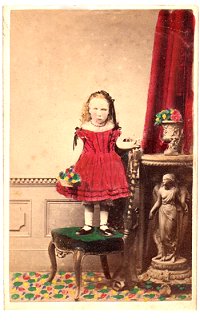 In the 1891
census
John
Tarver,
together with
his sister
Louisa and a
servant, were
living and
working at 6
Hendford. From
the 1890
advertisement
shown below, it
is clear that
the photographs
were also being
used to create
lifelike
portraits in oil
paints,
presumably by
Louisa (or
possibly in
Taunton by her
elder sisters
Kate and Maria
who had earlier
been listed as
artists), while
John Tarver
concentrated on
the photographic
side of the
business. (The example of
a photograph
painted over, at
the left, from
my collection is not by
Chaffin).
In the 1891
census
John
Tarver,
together with
his sister
Louisa and a
servant, were
living and
working at 6
Hendford. From
the 1890
advertisement
shown below, it
is clear that
the photographs
were also being
used to create
lifelike
portraits in oil
paints,
presumably by
Louisa (or
possibly in
Taunton by her
elder sisters
Kate and Maria
who had earlier
been listed as
artists), while
John Tarver
concentrated on
the photographic
side of the
business. (The example of
a photograph
painted over, at
the left, from
my collection is not by
Chaffin).
John Tarver, a bachelor, clearly had interests outside of work and the Western Gazette reported him being sworn in as a Special Police Constable in its edition of 4 November 1892 "....were sworn in as special constables for the ensuing year, before Dr Colmer (mayor) and M. William Cox: Albert Ernest Colmer, Charles Connock, John Chaffin, Thomas Thorne, William Henry Fletcher, Joseph John Brook, Samuel Leach, William Tucker".
John Tarver Chaffin died in Yeovil in the winter of 1919 aged 67 and with his passing ended nearly sixty years of the photographic studio in Yeovil started by his father.
For Chaffin Family Tree - click here
|
From
"Where
to Buy",
1895. Art has been making rapid strides in recent years, especially in photography, and the artist who has been able to keep abreast of the times and to hold his own among the various inventions and competition, must be a really clever manipulator, with a highly cultivated taste, and great experience. That these qualities are possessed in an eminent degree by the firm of John Chaffin and Sons, of Yeovil and Taunton, is evident by the large number of prizes and medals their works have won at international and other exhibitions during the past 20 years. Among others, they carried away the first prize of £50 (open to the world) at London in 1874; the Diploma of Honour at Brussels, the first class silver medal at the Bengal Exhibition held at Calcutta, and medals from London in 1882, Newcastle in 1881, and Cornwall on several occasions. The gallery and studios are situated in a convenient position at Hendford and are completely furnished with all the latest scientific appliances necessary to the production of high class photography. The studio is beautifully lighted, and is that in which the prize pictures were all taken. Groups and children's portraits are a speciality, outdoor photography, landscapes, equestrian pictures and buildings are faithfully and artistically reproduced. The firm have had a long experience and with characteristic enterprise, are constantly making improvements, introducing the most recent inventions. Among other additions to the apparatus is a powerful lens that magnifies to such an extent as to increase the seeing power of the human eye ninety times; and at the Taunton branch there is a Rose Camera weighing half a ton, which is so nicely balanced that a child could adjust it. The firm undertake every description of art work, including paintings on canvas, opaline, etc. and their reputation has been so well established during the past thirty years at Yeovil, that among all classes the very name of Chaffin is taken as a guarantee of superior artistic work; there are few persons of note in the district who have not at one time or another favoured Messrs. Chaffin with their patronage. Among the miscellaneous artistic work entrusted to the firm, they have often orders from a celebrated London glove house 40,000 or 50,000 miniature portraits of celebrities with which to adorn glove bands, the work being executed in a highly satisfactory manner by Messrs. Chaffin and Sons' patent permanent process.
|
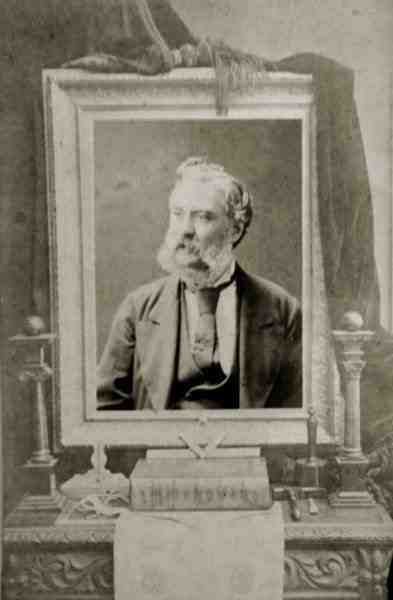
This photographic portrait, surrounded by Masonic symbols, is thought to be of John Chaffin and taken during 1872, the year he was made Worshipful Master of the Lodge of Brotherly Love.
Notes on Cartes de visite and Cabinet Cards
A Note on Multi-Image Cameras
Cartes de visite (also known as cartes or CDVs), were only introduced in Britain in 1859. They are small paper-on-card photographs, typically measuring 4" x 2½" (102mm x 62mm) and the photograph, which was pasted on to the card, was cut to about 3½" x 2¼" (90mm x 57mm). They were being used by Yeovil's early photographers within months of their national introduction.
CDVs were initially made with square corners, but by about 1872 CDV albums were becoming popular. It was found that square-cornered cartes frequently tore the album pages, so from around this time cartes began to be produced with rounded corners.
The great populariser of the carte de visite was André Disdéri, who in 1854 was granted patent for a means whereby several smaller images could be exposed on to a single 10in x 8in plate, thus reducing overall processing costs.
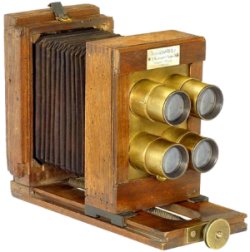 The
camera Disdéri
first used was
one invented by
Antoine Claudet,
and shown by him
at the Great
Exhibition in
1851.
The
camera Disdéri
first used was
one invented by
Antoine Claudet,
and shown by him
at the Great
Exhibition in
1851.
Claudet’s instrument, the ‘multiplying camera-obscura’, had a plate holder "Which could be mechanically moved both across and down to allow different areas of the emulsion to be covered by successive exposures through the same lens, to represent on the same surface a number of different pictures, or the same in various aspects, the portraits of several persons, etc."
Later cameras adopted by carte de visite photographers included those with four independent lenses as seen here which, working with a simple shift mechanism, could double up to take the usual set of eight images on the one plate.
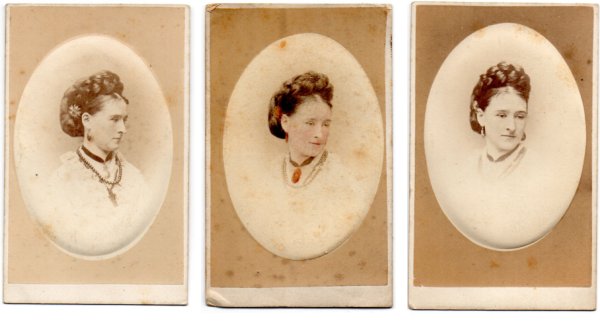
From my
collection
Three portraits of 'Aunt Minnie' by John Chaffin & Son. From the back design these all date to around 1871. Whether or not these were taken on a multi-image camera or not is all but impossible to tell (assuming the fourth photo is now missing). There are clearly three different poses all taken in the same session, but the processing treatment is different in each case. All three cartes have a central oval 'cushion' in which the portrait is made to stand out in three dimensions by shaping a raised portion. The oval framing of the photograph and the 3D cushion effect were a more expensive 'deluxe' option.
In the carte at left, Minnie's full panoply of necklaces are displayed. The centre carte has been slightly colourised by applying pale pink to her flesh and applying gold paint to her hair-ornament and necklace pendant while the number of necklaces has been reduced in the darkroom. At right, the necklaces and pendant are completely removed in processing leaving just the ribbon of the pendant.
A Note on CDVs and Cabinet Cards
As a general rule, CDVs were initially produced on a thin card stock. In the 1860s the average thickness was around 0.4mm, increasing to around 0.5mm in the 1870s and increasing to around 0.95mm or even 1mm thick in the 1890s.
However, the printed backs of CDVs and cabinet cards are among the best ways of dating them. Chaffin was using the carte de visite format from 1862 and the cabinet card format from at least 1875. Today, Chaffin's CDVs turn up frequently but cabinet cards by Chaffin seem to be very rare.
Initially, as seen from the first example below, the photographer would have bought card blanks from a local supplier, usually a printer, and simply wrote his name on the back. Very quickly, however, card stock with decorative standard printed backs became available from larger printing houses (see second example below) but the only way to get the price down to below the level of the customer's local printer, would be by economies of scale - that is, print a lot of the same design and try to sell them to everyone - this they tried to do using muted colour cards with a simple border as the second example.
Photographers, including Chaffin, began to have their name printed on the CDV back in a very simple way, probably pushed into it by the printer who was not getting any work out of this - a simple print did not add much to the cost of the card. Very quickly what was written on the back became a status symbol.
Around 1863-4 A
Marion & Co of
Soho Square,
London, was
established. By
1866 Marion was
employed
handling the
wholesale
publishing of
the sale of
'famous people'
carte de
visites,
for the top
London studio of
Mayall. By 1870
Marion were
making the backs
for sale to
photographers,
and had
travelling
salesmen
promoting their
product to the
smaller studios
using a standard
catalogue of
designs.
It is therefore not
uncommon to come
across the same
basic imagery
employed on the carte
backs of quite
different
establishments.
The designs were
created, of
course, not by
the
photographers
but by
commercial
printers, who
had access to
ready-drawn
imagery in the
form of stock
lithographic transfers.
Although it
appears that
Chaffin didn't
use Marion, they
certainly used
Trapp &
Münch
The design of carte backs became increasingly elaborate throughout the next few decades with most photographers (see, for example, the CDV backs of Adam Gosney). John Chaffin & Sons, from 1875 onwards went in a different advertising direction and began to illustrate the ever-increasing number of medals and awards that had been won. By the turn of the century, the backs of CDVs by Chaffin & Sons would be completely filled with images of the medals and awards they had won.
![]()
An unusual use for a carte de visite
Below is the front and back of a pre-printed "In Memoriam" card to commemorate a deceased person. The card is the size of a cabinet card, and will therefore fit into an album. It has a pre-cut aperture, in this case, oval, behind which a normal carte de visite is affixed allowing the image of the deceased to be seen.
It is thought that Chaffin, on request, would supply one or more reprints of an existing CDV of the deceased and attach it to an "In Memoriam" printed blank. This could then either be framed or placed in an album. That the top of this example has been trimmed, suggests the latter.
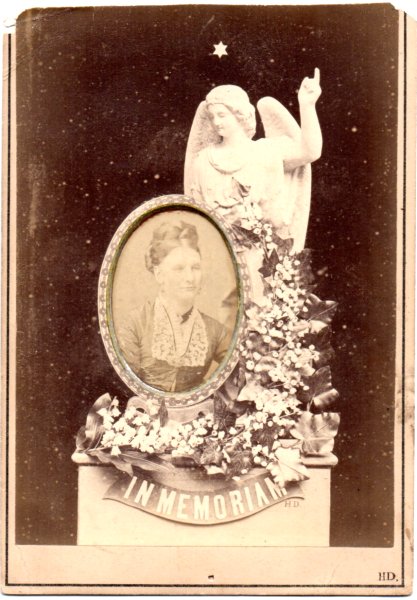
From my
collection
The front of the "In Memoriam" card with the CDV image showing through the cut-out aperture.
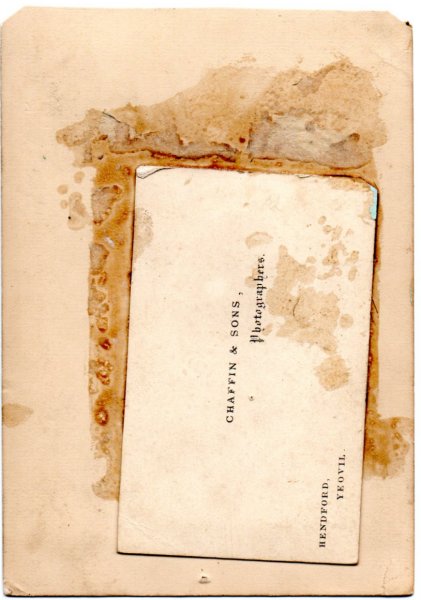
From my
collection
The back of the "In Memoriam" card showing haw the CDV has been affixed. The back design of the CDV (see below) dates the whole card/carte assembly to early 1874.
Dating Chaffin's Cartes de visite
At first glance it might appear difficult to date the output of any Victorian photographer with a degree of accuracy. However many images contain visual clues hinting at when the photograph was taken, with the presentation of the photographs themselves giving extra information.
Even from the early days, the photographers produced their photographs in a range of sizes, finishes, and so forth. For the second half of the nineteenth century the most popular form of photograph was the carte de visite.
Cartes of the 1860s are chiefly recognised by their square corners which changed gradually to rounded corners during the period 1872 to 1879. This was because albums were not only first introduced at this time, but were standardised from their earliest days and rounded corners enabled the cartes to slip into the album slots without tearing the page.
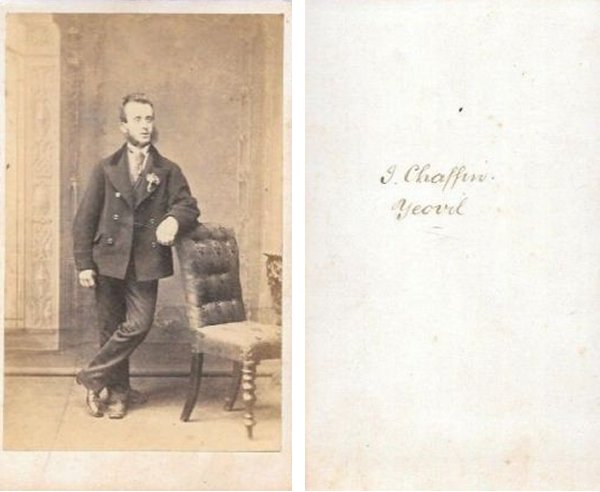
From my
collection
One of the very earliest cartes de visite by 36-year-old John Chaffin, almost certainly dating to 1862 when he first started his photographic studio in Hendford, next door to the Butchers' Arms. It should not be forgotten that, at this time, Chaffin was still trail-blazing photography in Yeovil and was in his experimental phase with the new carte de visite format. Consequently, the carte lacks his name on the front and, indeed, the back being hand-written indicates that Chaffin was producing cartes before he had even arranged for their backs to be printed professionally. The card stock, on which the photograph is mounted is white and very thin, just 0.41mm thick.
The man wears a sack coat which originated in France as the sacque coat during the 1840s, and took its name from the way it was cut (contrary to popular belief, the sack coat did NOT get its name from its loose fit “like a sack”). Other indicators of this very early date, apart from the sack coat (which gradually became more fitted) are the full length portrait with lots of space above the sitter's head and much carpet showing below the his feet, the square corners of the carte and the extremely simple, and very early, hand-written, back.
Just visible is the base of a neck clamp behind the sitter’s feet. Neck clamps were used in order to stop the sitter’s head moving in the days when cameras had very slow shutter speeds. The background to the portrait is a very simple painted backcloth of a pair of open double doors.
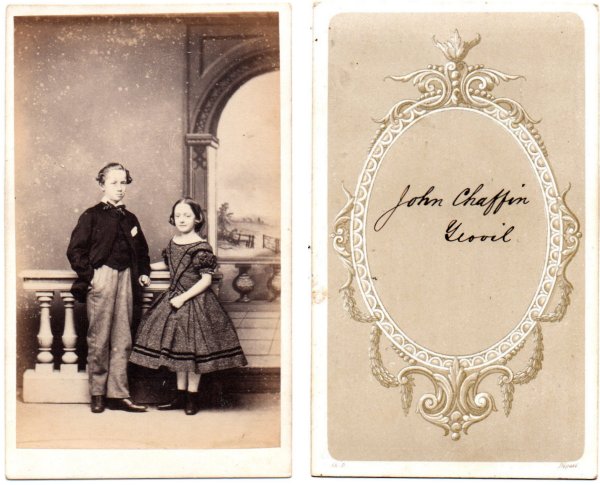
From my
collection
Again, one of the
very earliest
cartes de visite
by John Chaffin,
almost certainly dating
to 1862.
This time
Chaffin has
bought a more
professional-looking
but standardised
carte
with a printed
back. At the
bottom right the
word Déposé
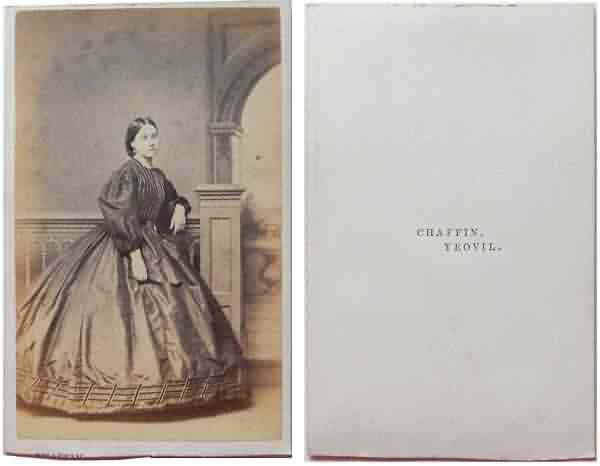
From my
collection
Another of the
earliest
cartes de visite
by John Chaffin.
Dating to
1862
when he first
started his
photographic
studio. This
date is deduced
from the style
of the lady's
fully
bell-shaped
crinoline dress
(which is a
touch out of
date, since
crinolines dramatically changed
shape around this
date), the full
length portrait,
the carte's
very simple back
and its square
corners. The
bottom edge of
this carte
has been cut
off, presumably
to better fit
within an album.
Note the re-use of the painted backdrop with a different balustrade studio prop. The painted backcloth is typical of the period and shows a simplified opening with a view through to the outside. The balustrade allowed the sitter to support themselves, thereby reducing as much movement as possible. At this time, with the primitive lenses employed combined with the slow shutter speeds, any degree of movement on the sitter's part could result in a blurred image being produced.
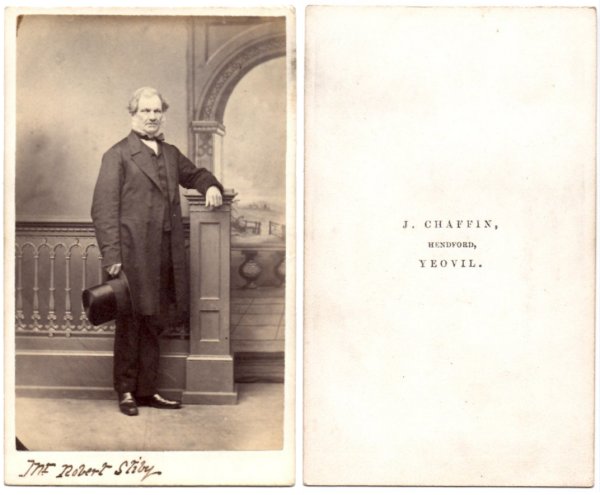
Courtesy of
Richard Scott
This carte, with an almost identical back to the previous carte, also employs the exact same painted backdrop and balustrade studio prop. This carte is of Robert Stiby, father of Henry Stiby later mayor of Yeovil. Robert Stiby Snr died in 1866, thereby confirming an early to mid-1860s date for the carte.
Cartes were a cheap way of getting your photograph taken and almost anyone could afford it. They were sold in sets of six or twelve, some identical, or sometimes with slight variations on the pose. The camera may have used multiple lenses or the plate slider was repositioned to take the different poses on one plate. The contact print was then cut up and pasted on the card.
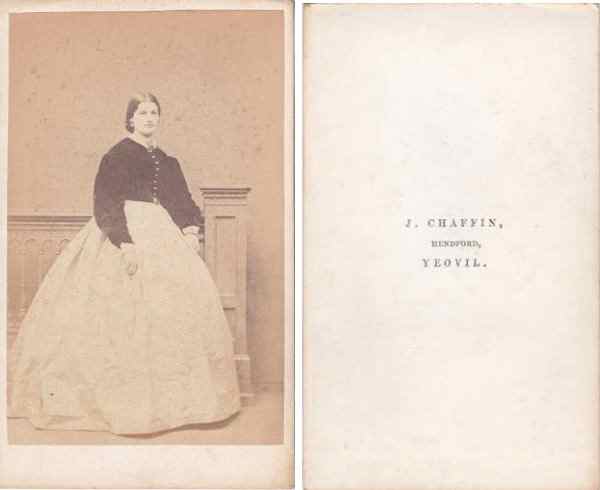
From
“Secure
the
Shadow,
Somerset
Photographers
1839-1939“
courtesy
of Robin
Ansell,
Allan
Collier
and Phil
Nichols.
The shape of the lady's skirts are now somewhat flattened at the front, rather than the earlier, symmetrical bell-shape, dating the carte to the mid-1860s. On this occasion, the painted backdrop has been omitted, but the balustrade studio prop remains.
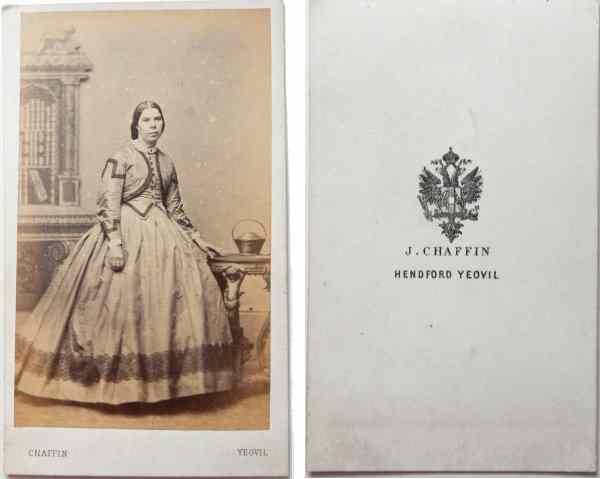
From my
collection
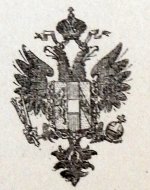 This
is a really
difficult
carte to
explain. The
style of the
lady's clothes
would appear to
date it to the
early-1860s.
This
is a really
difficult
carte to
explain. The
style of the
lady's clothes
would appear to
date it to the
early-1860s.
However, the
logo on the back,
enlarged at
left,
features the
double-headed
eagle of the
House of
Habsburg-Lorraine.
When the Holy
Roman Empire was
dissolved in
1806, the
Habsburgs
adopted parts of
the symbolic
imagery of the
old empire for
the Austrian
Empire, which
was now fully
bound up with
the dynasty.
Henceforth, the
double-headed
eagle was
Austrian. It
lost its
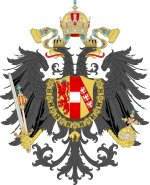 nimbus,
bore an
inescutcheon
with the coat of
arms of the
House of
Habsburg-Lorraine,
and was
supplemented
with the Order
of the Golden
Fleece. Above
this hovered the
Austrian
imperial crown.
The dual
monarchy of
Austria-Hungary
was founded in
1867, thereby
suggesting a
date for this
carte
design but
making the
lady's dress
quite
old-fashioned. Why
Chaffin would
use such a
symbol is a
complete
mystery. A
special
commission
perhaps?
although the
design has been
noted on other
cartes
by Chaffin.
nimbus,
bore an
inescutcheon
with the coat of
arms of the
House of
Habsburg-Lorraine,
and was
supplemented
with the Order
of the Golden
Fleece. Above
this hovered the
Austrian
imperial crown.
The dual
monarchy of
Austria-Hungary
was founded in
1867, thereby
suggesting a
date for this
carte
design but
making the
lady's dress
quite
old-fashioned. Why
Chaffin would
use such a
symbol is a
complete
mystery. A
special
commission
perhaps?
although the
design has been
noted on other
cartes
by Chaffin.
As to the photograph itself, from this point onwards Chaffin seems to have dispensed with painted backcloths for over a decade, concentrating on plain backgrounds or, perhaps, the occasional use of a draped fabric swag to one side or the other. He also usually included one of several very decoratively carved occasional tables, often with a small vase of flowers or books, as well as a chair - either to be sat in by the sitter or simply held by the sitter in order to steady themselves during the long exposure times. There are several examples below.
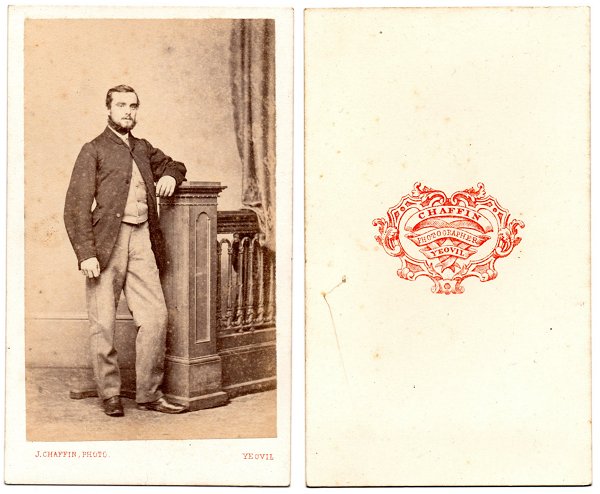
From my
collection
Generally, if you look at the image of a standing or sitting person in a photograph of the period and you can see both head and feet with a carpet, some old furniture and studio props such as a curtain, it is usually from the first half of the 1860s. The small logo seen here on the back is typical of the period, even a little flamboyant, and is a stock back from one of the large printers.
It is an early design to feature on the back of a John Chaffin carte - probably dating to late 1863, but certainly before 1864 when Chaffin became a Freemason and began including masonic symbols in his logo as shown in the next example.
The cardstock is a standard printed type that would have been usually taken around to photographers by a printer's representative, usually from a large printing concern (such as Marion) with a nationwide chain of representatives, as the same designs are frequently seen on cartes by photographers around the country. The sample printed back shown to the photographer would have no photographer's information, which would be included at the time of printing. That the representative would make regular visites to the photographer is evidenced by the frequency with which the back designs would change.
Note the base of a head clamp behind the sitter’s feet. Head clamps were used in order to stop the sitter’s head moving in the days when cameras had very slow shutter speeds. Note also the re-use of the balustrade studio prop which, in this instance, has been re-aligned demonstrating that it was moveable.
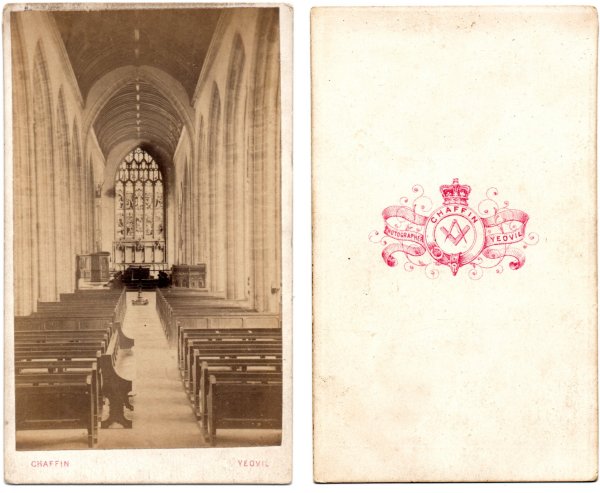
From my
collection
A rare architectural interior carte de visite, dating to around 1865, by John Chaffin featuring a view of the interior of St John's church looking east to the chancel. This must be one of the earliest photographs of St John's interior.
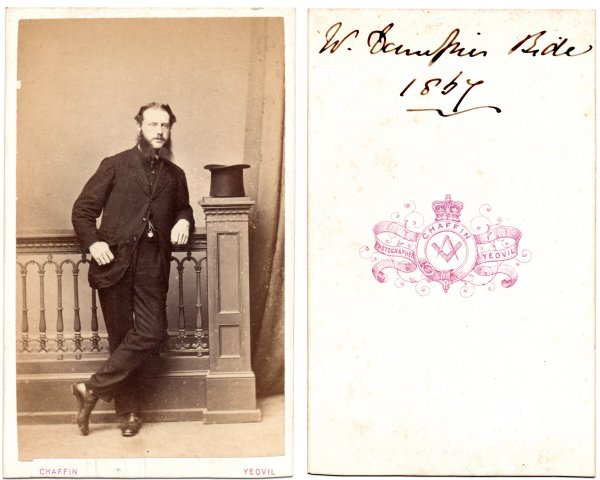
From my
collection
This is a named and dated CDV of 23-year-old Thomas William Dampier-Bide, known as Willie (who donated Bide's Gardens to the town),
The new 'crowned belt' logo on the back became the standard John Chaffin logo for a couple of years. The central emblem (and the printer's stock design) of a masonic 'Square and Compass' (Chaffin became a freemason in 1864) was quickly replaced by nondescript curlicues thus dating this particular style of CDV back to between 1864 and 1867.
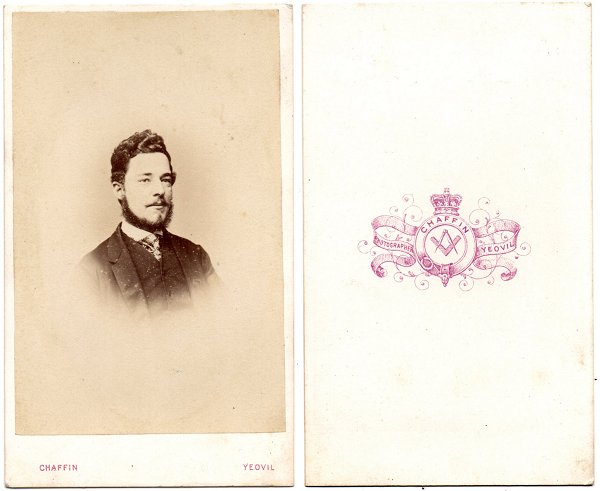
From my
collection
Again, featuring the early 'Masonic' logo, this carte of between 1864 and 1867 demonstrates that John Chaffin was experimenting with his photography and producing small 'head and shoulder' cartes as well as traditional full-length studies.
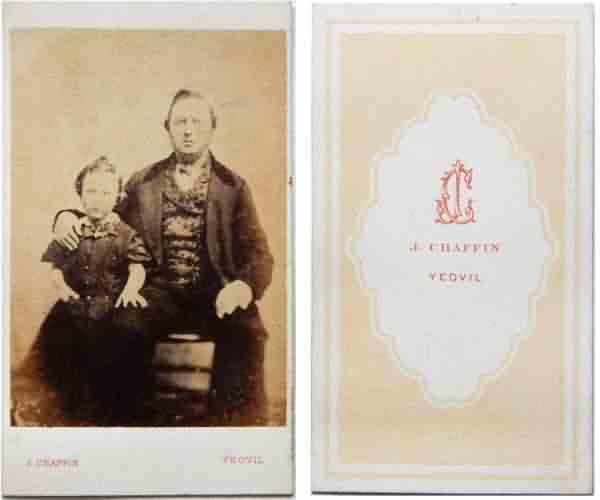
From my
collection
Another early Chaffin carte, from around 1867, with a slightly more elaborate back, featuring an intertwined 'JC' logo. Again, a simple standard blank back design chosen from a printer's catalogue that would then have been overprinted with Chaffin's details.
The absence of background 'props' and a painted backcloth are often a sign of a very early photograph. Children were often supported by a parent in order to stop them wriggling about during the relatively long exposure times, which would result in a blurred image.
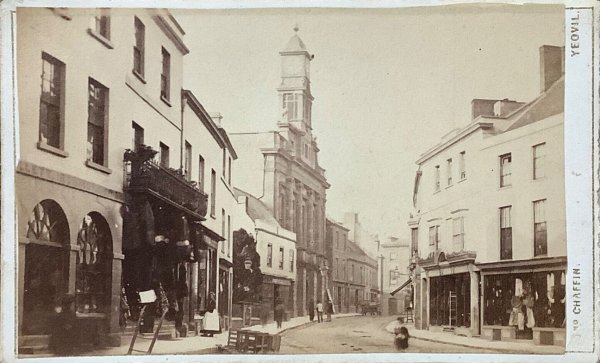
From my
collection
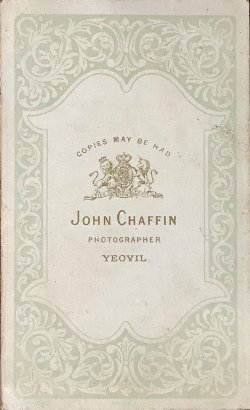 From my collection |
From the style of the back of the CDV (another simple standard blank back design chosen from a printer's catalogue and then overprinted with Chaffin's details), seen at left, it was taken in early 1868. This is suggested by the use of the crest, which Chaffin continued to use for a while, even when his son Thomas became a partner in the business that became Chaffin & Son in 1869. The carte de visite is, I believe, the only known photograph depicting the Town Hall with its original clock tower. Although the Town Hall had been built in 1849, the clock tower seen above, was only added in 1862. It was declared unsafe in 1887, and was dismantled that same year. |
A new steel-framed clock tower was erected in 1912, designed to evenly distribute the great weight of the clock tower. It would appear that the later tower's design was based on that of the former, although there are very minor differences.
The phrase "Copies may be had" was beginning to be widely used by photographers, since reprints were a lucrative source of income without having to take another photograph - something which had not been possible with earlier photographic processes such as the daguerreotype or ambrotype.
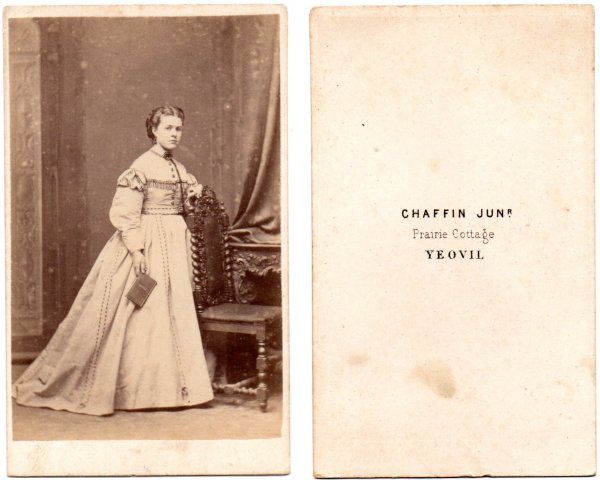
From my
collection
This carte de visite by Chaffin Jnr, dates to the brief period a subsidiary studio was at Prairie Cottage, London Road, on the site of today's old Western Gazette offices. Chaffin Jnr (Thomas)was at Prairie Cottage from around 1868 (after George Bartlett Coggan had left) until 1869 when the studio closed - thereby dating this carte.
Since the business did not become Chaffin & Son until 1869, I suspect that this was a studio run not only as a branch of the family firm by his son Thomas, (who would have been in his late teens) but also as an in-at-the-deep-end training opportunity for the young Chaffin. Consequently, this carte is almost certainly by Thomas Chaffin.
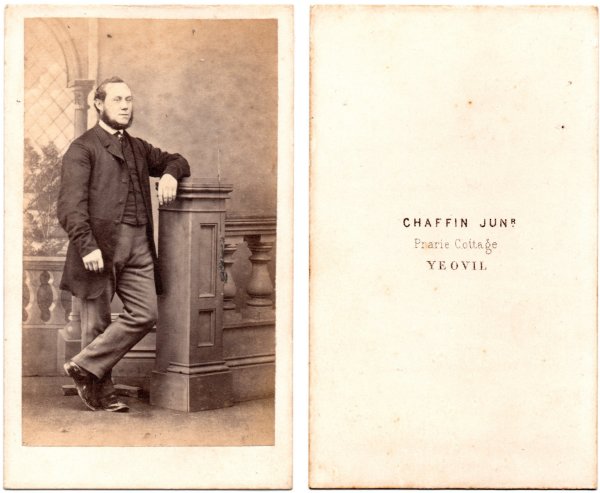
From my
collection
Another carte de visite by Chaffin Jnr. Apparently a plethora of balustrades, although the one behind the man is a part of the painted backdrop, while he rests on a moveable studio prop - very similar, but slightly different, to that in the main studio. Note the feet of a neck brace behind the man’s feet.
The man wears a high-buttoned single-breasted jacket with matching waistcoat and contrasting trousers of the period.
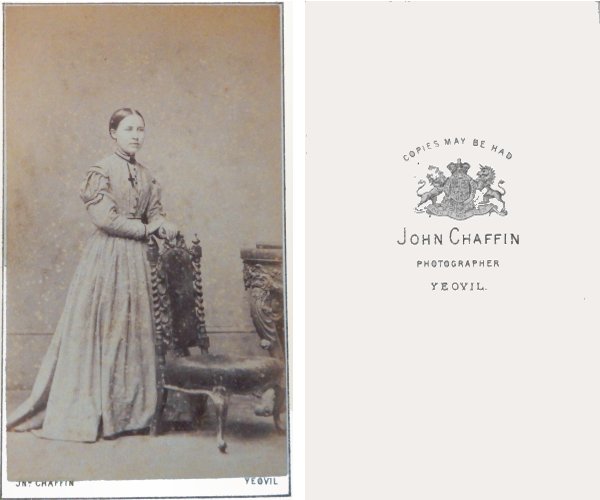
From my
collection
Thought to date from 1868 substantiated by the lady's hairstyle and dress. (Concerning ladies' hair fashions; if you can see the lady's ears, as in this example, it is the later 1860s or early 1870s.)
This carte has the final back design used by John Chaffin while working on his own. Whether or not Chaffin used the royal crest with permission is unknown, but I could find no mention of its use being granted in the records.

From my
collection
A square-cornered (the corners appear rounded but actually are worn) carte de visite by 'Chaffin & Son' (singular). This carte is the first attributed to Chaffin & Son and, since the back is almost identical to the previous carte (when Chaffin was working solo) and the front is unprinted. It is almost certainly the first 'interim' design after Thomas became a partner. It therefore dates to early 1869.
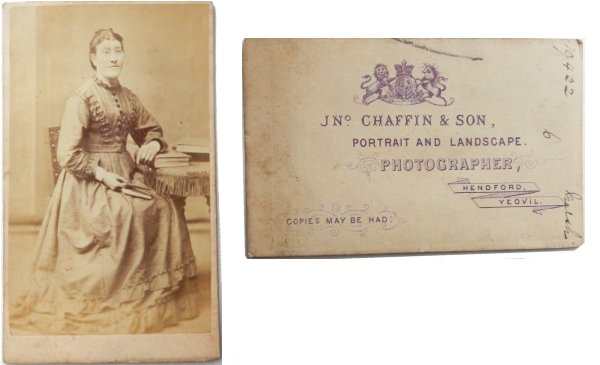
From my
collection
A new style back for cartes de visite by John Chaffin & Son, but retaining the royal crest. The landscape-format back is unusual for this period. This square-cornered carte dates to around 1869, confirmed by the lady's costume.
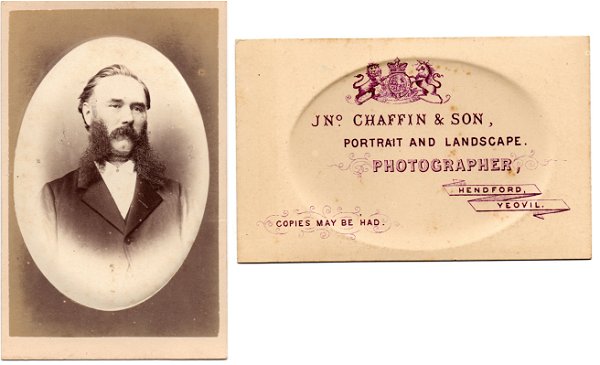
From my
collection
A carte de visite by John Chaffin & Son with a central oval 'cushion' in which the portrait is made to stand out in three dimensions by shaping a raised portion as seen at right - the oval framing of the photograph and the 3D cushion effect were a more expensive 'deluxe' option - as opposed to the regular option above. This square-cornered carte also dates to around 1869 and portrays Dr William Fancourt Tomkins, eminent Yeovil surgeon (identified from a name tag that was in the original carte album).
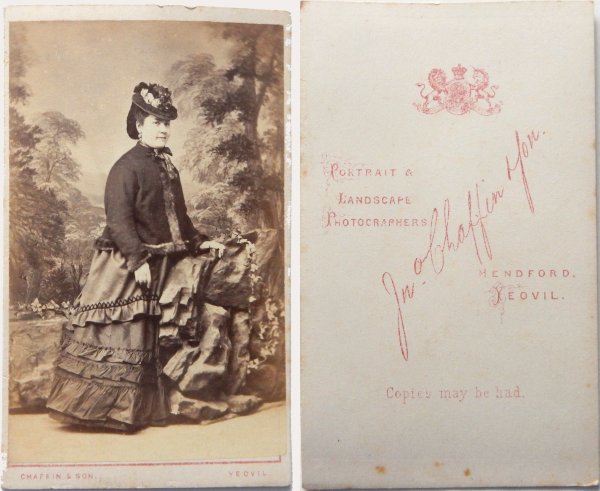
From my
collection
Another square-cornered carte de visite by 'Chaffin & Son' employing the same back as the next carte but in a different colour - probably dating to late 1869 or early 1870. The style of the lady's dress suggests this is the later of the two. The carte employs a standard blank back design (many examples from other photographers across England are known) chosen from a printer's catalogue, that would then have been modified with Chaffin's details.
This is the first occasion that 'Chaffin & Son' appears on the front of a carte and the first use of a painted background in over a decade. This is an early use of an elaborately painted 'outdoor' backcloth, the style of which didn't really become fashionable for another five years or so. Indeed, an advertisement placed in the 30 July 1869 edition of the Western Gazette (see Gallery) notes "Chaffin and Son's New Rustic Carte de Visite Portraits".
Also, note the massive 'rock' posing aid which the lady rests herself against, and places her hand on, in order to maintain her pose. It is likely that Chaffin's daughters Kate and Maria, aged 19 and 18 respectively, who were both artists, had a hand in the creation of the painted background. They may also have created the 'rock', presumably in papier-mâché on a wooden frame - it is possible to see that the 'rock' rests on a wooden base.
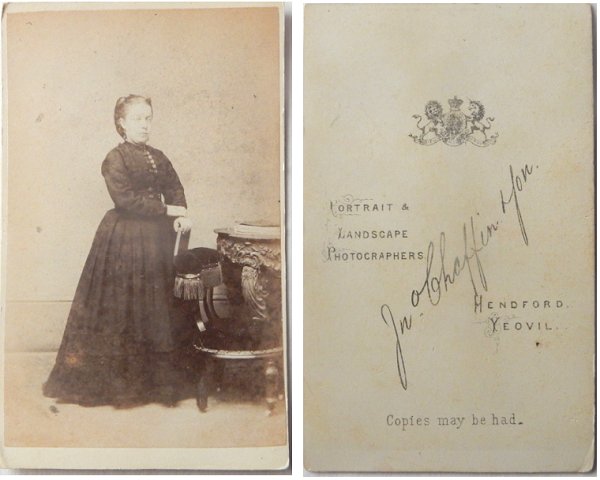
From my
collection
A square-cornered carte de visite by 'Chaffin & Son' (singular). The back is the new 'diagonal script signature', also featuring the royal crest, suggesting a date of, say, 1870. The royal crest disappears after this date from the back of Chaffin's cartes.
Of particular interest in this carte is the chair featured. This is not a normal chair but a photographer's 'posing' chair. This was designed such that the 'seat' could be used for sitting or kneeling and the height of the padded back would have been adjustable, to accommodate sitters of different heights. In this instance, however, the lady uses her own cane walking stick to steady herself in order to maintain her pose.
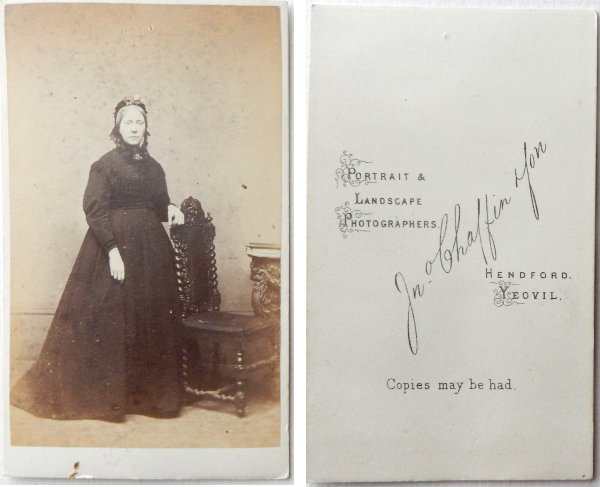
From my
collection
A square-cornered carte de visite by 'Chaffin & Son' (singular), with the standard printer's catalogue 'diagonal script signature' on the reverse, but lacking the royal crest. The fancy curlicues around the letters 'P' in both portrait and photographers and the 'Y' of Yeovil, are quite pronounced (and fade to virtually nothing in subsequent issues) suggesting a date of around 1871 - confirmed by the style of the lady's dress.
The back of this carte is the same as the triple portraits of 'Aunt Minnie' above, thereby dating Minnie's portrait session.
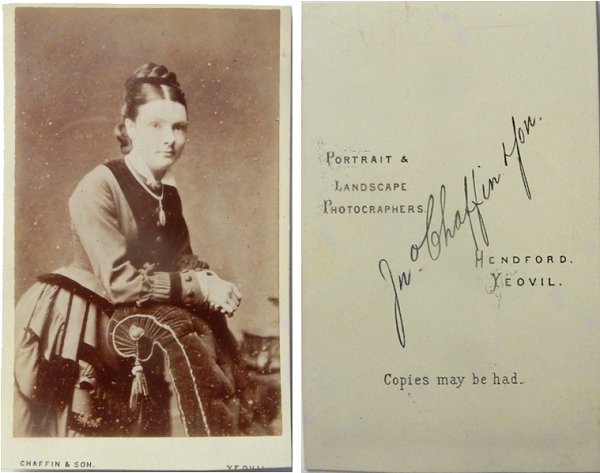
From my
collection
A carte de visite by 'Chaffin & Son' (singular), still square-cornered and with the 'diagonal script signature' on the reverse but with the curlicues of the preceding carte almost absent. The later crest seen in the following example is yet to be used. The suggested date of this carte is late 1871 or early 1872.
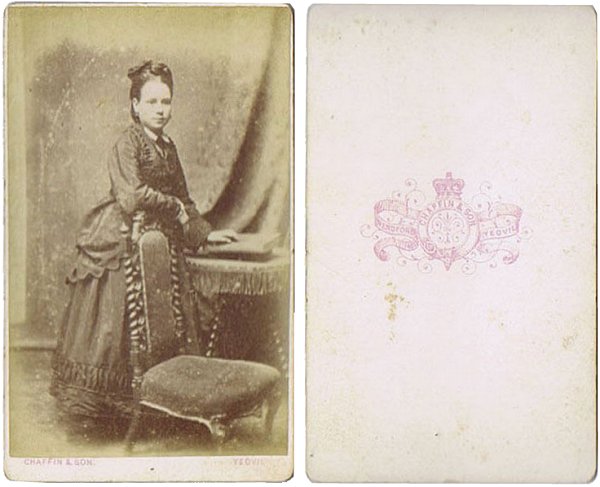
From my
collection
An image showing both head and feet with a carpet, some old furniture and studio props such as a curtain, as in this example, is a style typical of the early 1870s confirmed by the rounded corners of the carte and the lady's costume. Her hand placed on a book was often employed as a symbol alluding to education and learning.
Note the
revised 'house'
logo - a
printer's stock
image adapted
for the
individual
photographer.
The earlier
central emblem
makes a return
but the masonic
'Square and
Compass' has now
been replaced by
nondescript
curlicues.
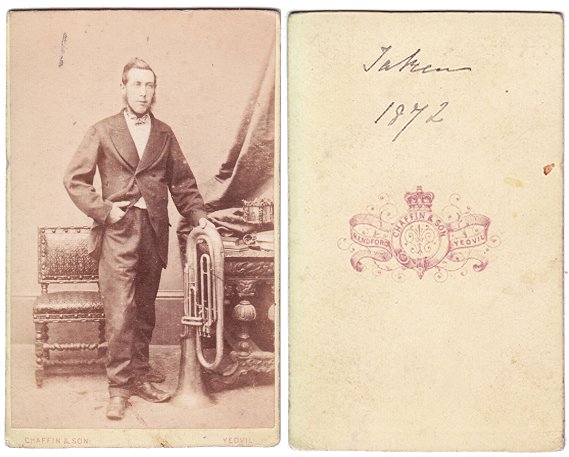
A carte de visite by John Chaffin & Son but helpfully inscribed with the date 1872 on the reverse. That the carpet is seen below the sitter's feet, together with an array of background props, suggests that Chaffin's style of portraiture was becoming a little old-fashioned for this date.
Nevertheless, the sitter's (presumably) own prop of a tuba (or similar) is quite unusual and instantly displays to anyone looking at the carte that the sitter has a musical talent.
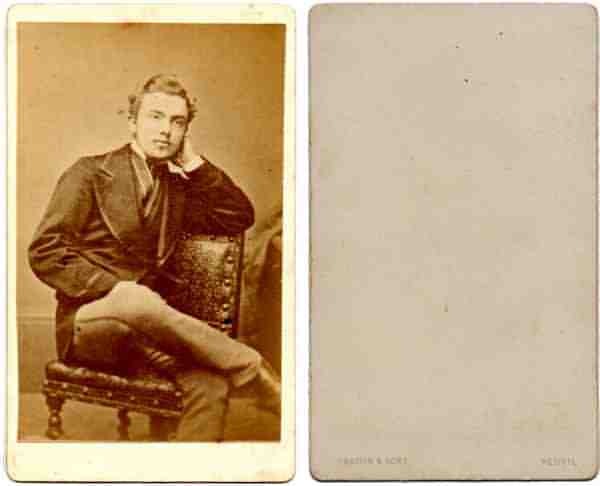
From my
collection
A very rare carte de visite of a Yeovil man by Chaffin & Sons (plural). The design of this carte’s back with its very tiny and feint "Chaffin & Sons" and "Yeovil", plus the lack of printing on the front, probably makes it the first interim design used when his son John officially became a partner in the business, thereby dating it to early 1874. This date is confirmed by the man's sack coat with very wide lapels which went out of fashion shortly after this date. It is likely that this back design was only used for a matter of weeks.
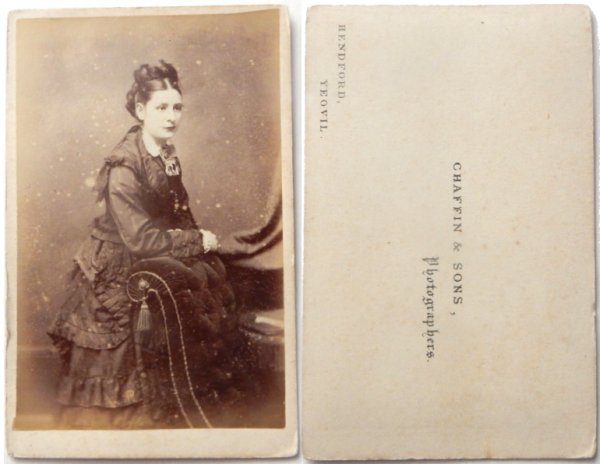
From my
collection
A carte de visite of a Yeovil lady by Chaffin & Sons (plural). The design of this carte’s back, plus the lack of printing on the front, is clearly another interim design used when his son John officially became a partner in the business, thereby dating it to early 1874 - confirmed by the lady's dress with its many gathered 'aprons'. This style of back is far more common than the previous example.
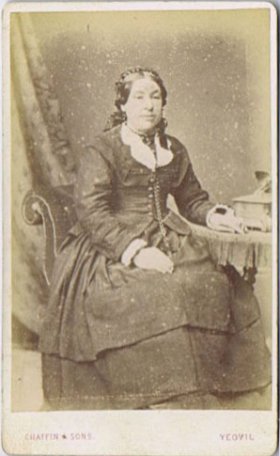 |
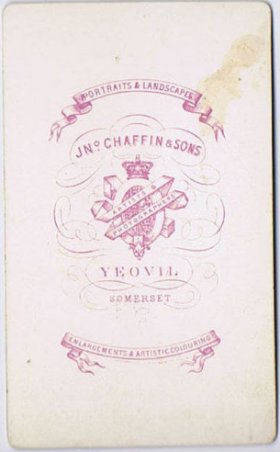 |
From my collection
A carte de visite of a Yeovil lady by Chaffin & Sons (plural) after son John joined the business in 1874, but before the Chaffins won their first prize of £50 later that year. The crest on the fashionably elaborate back, the standard 'Artists & Photographers' ribbon crest, was to become the new house design for Chaffin & Sons, but would be replaced by 1875 after the first medal was awarded.
During this period the backs of cartes generally became larger and more elaborate - not just with Chaffin, but with most photographers. This was, however, probably the last printer's stock back design to be used by Chaffin.
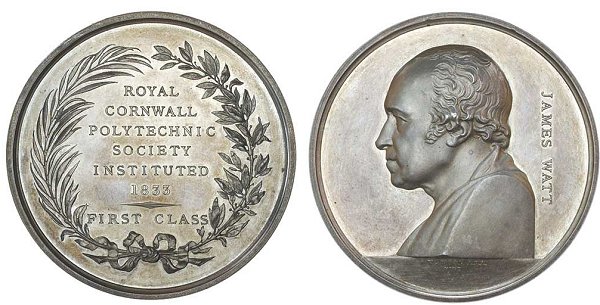
Courtesy of
Bernard Begley
This is the actual exhibition medal awarded to John Chaffin & Sons in 1875. It is 45mm in diameter and made of silver.
Interestingly the edge inscription shown around the medal image on the carte de visite is not quite the same as that on the medal's edge. On the medal it reads: J. CHAFFIN & SONS. FOR GROUP "THE CHESS PLAYERS". 1875. There is no "TO" at the start of the engraving. The wording shown around the portrait of James Watt (the reverse of the medal) on the carte de visite, "AND FOR GENERAL EXCELLENCE IN PORTRAITURE" is not engraved on the medal.
Chaffin & Sons would eventually acquire twenty awards and medals for their photography and the backs of their cartes gradually showed an ever-increasing number of them as a form of advertising their superior abilities.
In contrast to the general trend of carte backs becoming ever more elaborate, the following four examples all of a basic design tend to get plainer.
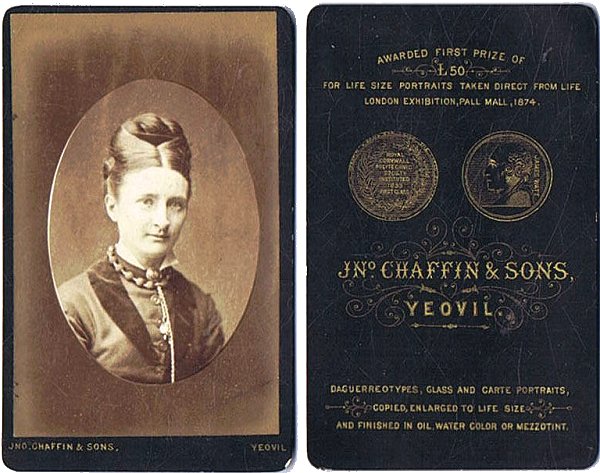
From my
collection
This carte de visite by 'Jno Chaffin & Sons' has ornate curlicues around Chaffin's name and Yeovil. It also boats three lines of advertising at the bottom.
This carte design was used from 1875 to 1876.
This example with gold lettering on a chocolate brown thick card stock is a "top of the range" deluxe style and appropriately more expensive as a status symbol for the sitter. The 'normal' carte in this style was on a cream coloured, thinner card stock.
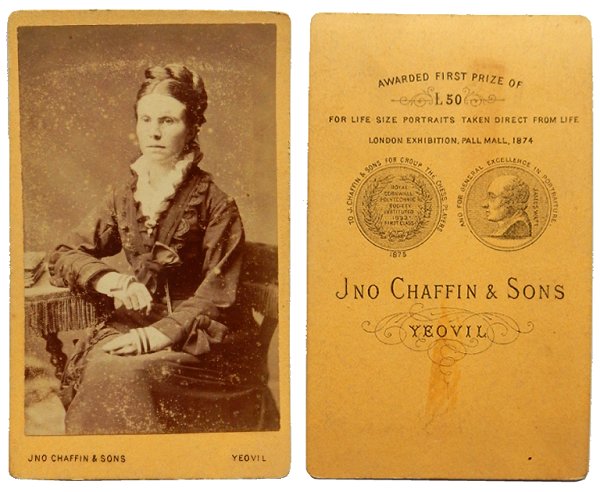
From my
collection
The second of
the three
carte
designs has less
fussy curlicues
around Chaffin's
name and Yeovil,
and the
advertising text
at the bottom of
the carte
has disappeared.
This carte design was used from 1876 to 1877.
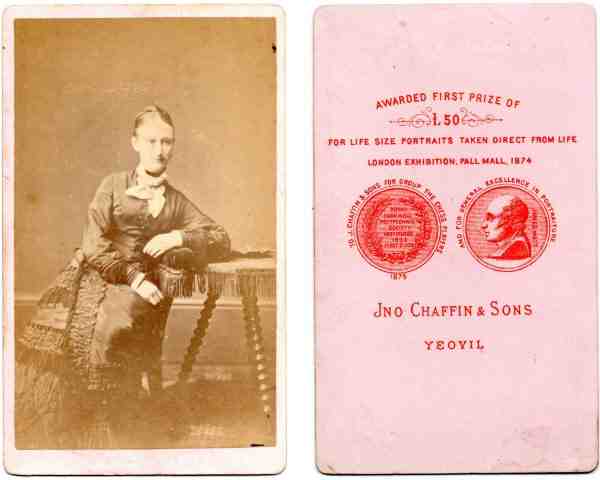
From my
collection
This is the third design in this series of cartes de visite by 'Jno Chaffin & Sons'. With even plainer text, this carte design was issued in at least three colours of card stock - pink (as here), cream and buff-orange - all with printing in red.
This carte design was used from 1877 to early 1879.
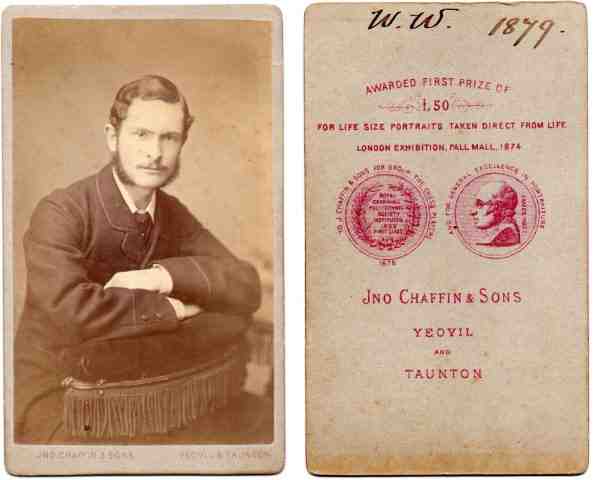
From my
collection
This is the fourth, and final, design in this series of cartes de visite. Only issued for a few months in late 1879 after the Taunton branch opened, and the backs are printed with 'Yeovil and Taunton'. The only card stock seen to carry this design is a drab grey-brown with dark red printing.
Although this carte is dated 1879, the new design that included the 1878 medal was already being used (see the next carte) - certainly in the Yeovil studio. It may be that this design was an interim design while new artwork was completed for the Taunton studio in the following design.
The man sits astride the adjustable photographer's posing chair, with his arms folded on the backrest.
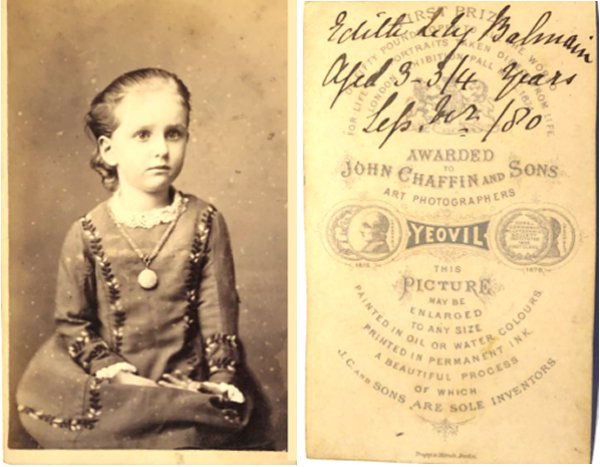
From my
collection
Having won
another prize
medal at the
beginning of
1878, the backs
of Chaffin's
cartes were
redesigned to
show both the
1875 and 1878
medals, with the
word 'Yeovil'
between them. A
bit of
advertising notes that
the carte is
"Printed in
permanent ink. A
beautiful
process of which
JC and Sons are
Sole Inventors".
Their beautiful
process may not
have proved too
successful since
it is never
mentioned in
their
advertising
again.
This carte
back was
introduced in
November 1878
and was
certainly in use
until
September 1880
as
witnessed by
this dated
carte. This is
a card
stock obtained
from Trapp &
Münch
Colonel John Henry Balmain and Louisa Edith née Gooch (1845-1918), of Hewhill House, West Coker, had two daughters; Edith Lily (1876-1973) and Muriel Charlotte (b1879). The carte above, of 3¾-year-old Edith was taken in September 1880. The carte below of Muriel, with the revised back design, was probably taken in 1881.
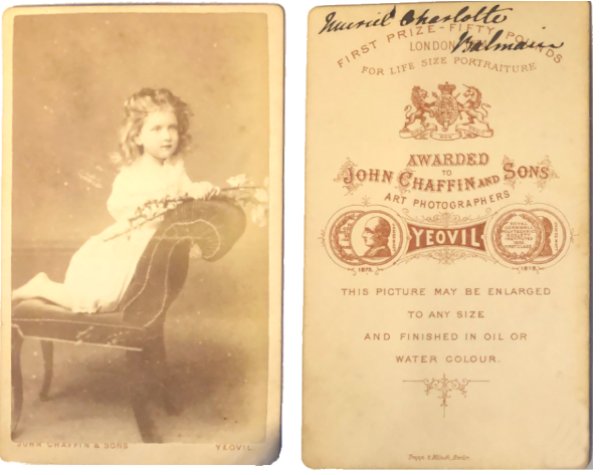
From my
collection
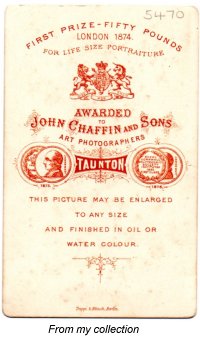 The
printed card stock was
also obtained from
Trapp &
Münch
The
printed card stock was
also obtained from
Trapp &
Münch
Chaffin & Sons expanded and opened premises in Taunton around 1878. John briefly moved his family to Taunton while that enterprise got established.
To distinguish
the output of
the two studios,
the back was
printed to
incorporate
either 'Yeovil'
or 'Taunton' as
seen
at the left.
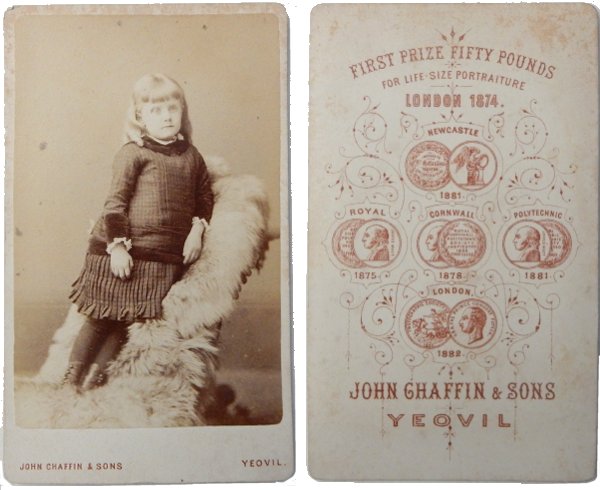
From my
collection
A carte de visite by 'John Chaffin & Sons'. This carte is from 1882 (when Chaffin was awarded a further exhibition medal) or shortly thereafter.
This carte again features the photographer’s adjustable 'posing' chair, in this instance draped in a sheepskin. The back of the chair is fully extended, and set at an angle, to provide support for the young girl in an attempt to stop her moving during the exposure. Even so, there is a slight blurring effect to the girl's face, especially noticeable around her eyes, where she has moved slightly during the exposure.
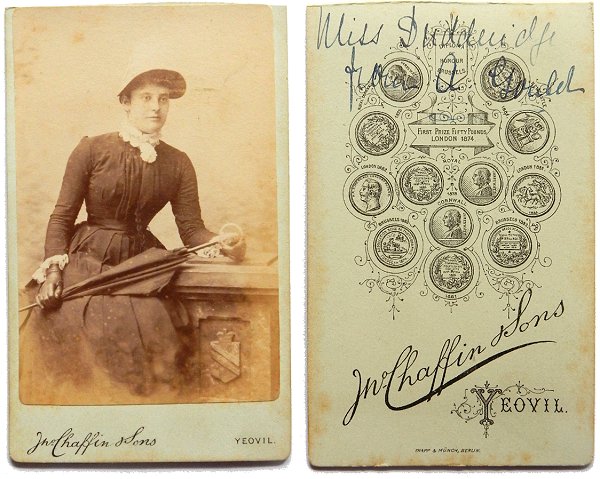
From my
collection
In 1883 Chaffin won two further exhibition medals, added to the back design of this carte de visite This was almost certainly a slightly later date than 1883 and is a new card stock which in this instance was ordered from Trapp & Münch of Berlin. Note, when comparing this carte with the following, that the bottom four medals are laid out in a 1 - 2 - 1 layout.
The umbrella is an unusual prop for an indoor photograph. The carte has been roughly trimmed at the top, presumably to fit in an album.
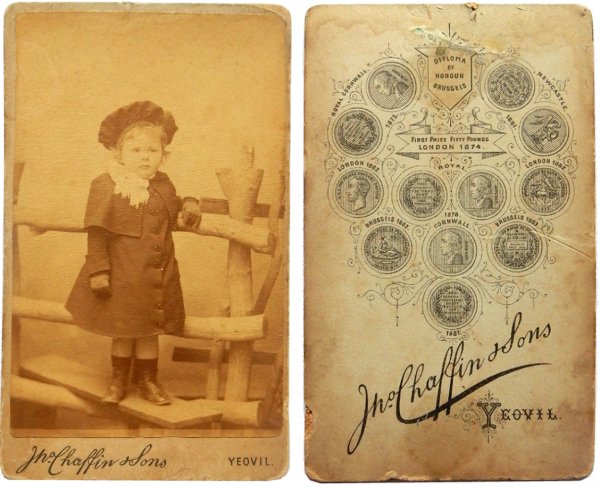
From my
collection
The same 1883 exhibition medals are included on this carte of a small child on an elaborate rural style studio prop by 'John Chaffin & Sons'. At this time young children were dressed almost identically - I've even got a photo of my granddad wearing a dress when he was a toddler, around 1903.
The back is in a
slightly
different design
(the bottom four
in a 3 - 1
format), but
this is the
later style used
into the early
1890s (see
next).
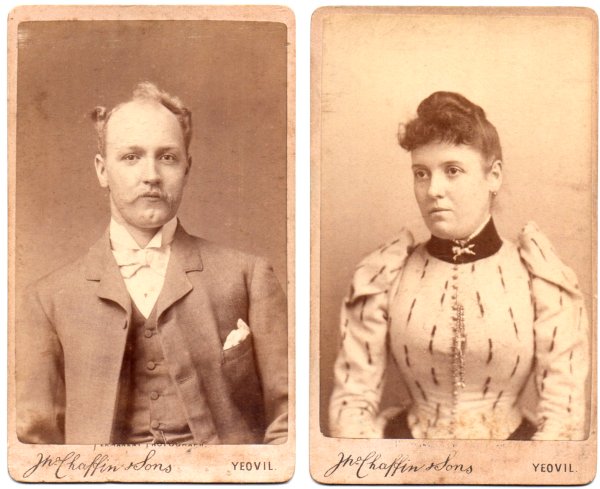
From my
collection
An unknown Yeovil couple, each with their own carte and photographed in the 1890s; the lady's leg-of-mutton sleeves were only fashionable during this decade and the backs (see next photo) lack the 1901 awards as listed in the following carte.
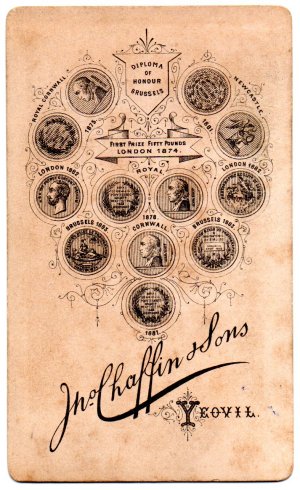
From my
collection
The backs (identical) of the cartes of the couple above lack the "Awards 1901. Paris, Calcutta, Le Puys, Brussels" of the following carte, therefore confirming the 1890's date.
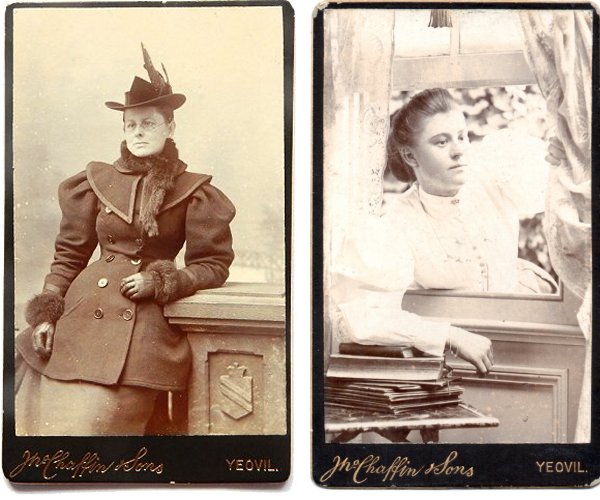
From my
collection
John Chaffin died in Yeovil in 1885 and the family business was continued by his sons, keeping the name John Chaffin & Sons.
By the 1890s it became fashionable for photographers to use plain backs to their cartes de visite, in this case chocolate brown, on a much thicker cardstock of 0.95mm and employing gold embossed lettering on the front.
At left above, the sitter's coat has the 'leg of mutton' sleeves that were only fashionable in the early to mid 1890s. The photograph at right has a very unusual, and innovative, pose of the young lady reaching in through an open window.
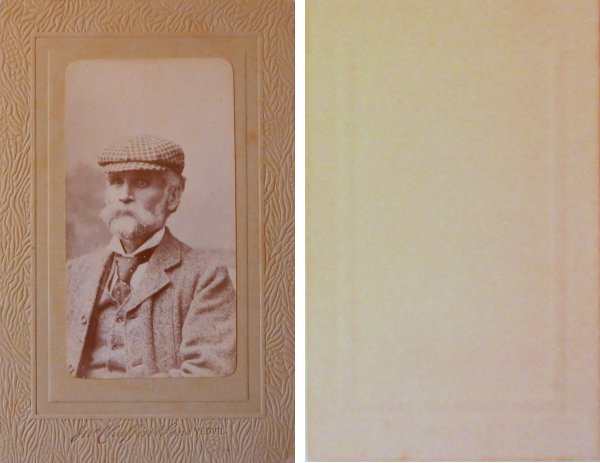
From my
collection
The plain back, coupled with a very stout cardstock that has been heavily embossed, dates this carte to the late 1890s and was probably taken shortly before cartes de visite were completely phased out in favour of the larger cabinet cards.
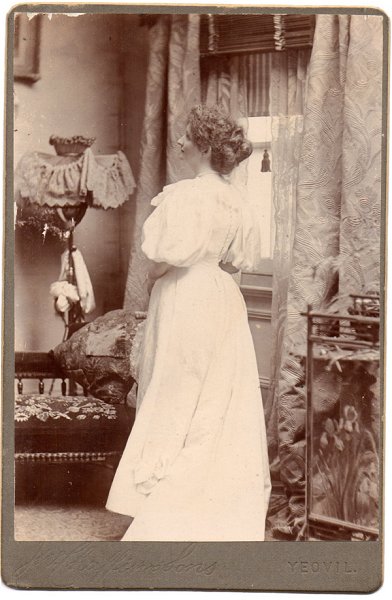
From my
collection
An unusual, yet charming, cabinet card (165mm x 105mm) which, judging by the 'leg of mutton' sleeves of the sitter's dress, also dates to the 1890s and either shows a little more than normal of Chaffin's studio or, more likely, was a location shot taken at the sitter's home. The back of this cabinet card is identical to the last back shown above but in a mid-brown.
It was during
this decade that
the larger
cabinet cards
began to replace
cartes de
visite
(typically
102mm x 62mm) in
popularity, even
though they had
been available
since 1866.
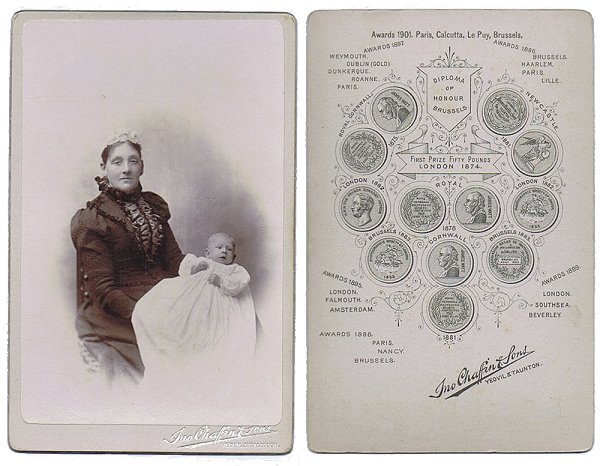
From my
collection
A post-1901 cabinet card listing the vast array of awards the company had received - including those awarded in 1901 in Paris, Calcutta, Le Puy and Brussels.
CHAFFIN Exhibitions at the Royal Photographic Society 1870-1915
| 1874 | Chaffin & Sons | 'Three Heads, taken direct from life' |
| 1874 | Chaffin & Sons | 'Three Heads, taken direct from life' |
| 1875 | Chaffin & Sons | 'Rose' |
| 1875 | Chaffin & Sons | 'Charlie' |
| 1875 | Chaffin & Sons | 'Marie' |
| 1875 | Chaffin & Sons | 'Seaside' |
| 1875 | Chaffin & Sons | 'Silver Grey' |
| 1875 | Chaffin & Sons | 'Belle and Bow' |
| 1875 | Chaffin & Sons | 'Tom' |
| 1876 | J Chaffin and Sons | Checkmated |
| 1876 | J Chaffin and Sons | 'Trio' |
| 1876 | J. Chaffin and Sons | 'Kate' |
| 1878 | John Chaffin and Sons | 'Meditation' |
| 1878 | John Chaffin and Sons | 'Expecting Jack Home To-day' |
| 1878 | John Chaffin and Sons | 'Yes or No' |
| 1878 | John Chaffin and Sons | 'Criticism' |
| 1878 | John Chaffin and Sons | 'Visiting the Studio' |
| 1881 | J Chaffin & Sons | 'Fair Correspondent' |
| 1881 | J Chaffin & Sons | 'The Signal' |
| 1881 | J Chaffin & Sons | 'Innocence' |
| 1881 | J Chaffin & Sons | 'My Pet' |
| 1882 | John Chaffin and Sons | 'The Tambourine' |
| 1882 | John Chaffin and Sons | 'Cherry Ripe' |
| 1882 | John Chaffin and Sons | 'Sisterly Intercession' |
| 1883 | J Chaffin & Sons | 'The Truants' |
| 1883 | J Chaffin & Sons | 'On Pleasure Bound' |
| 1883 | J Chaffin & Sons | 'Chit-Chat' |
| 1883 | J Chaffin & Sons | 'Too late' |
| 1884 | Jno. Chaffin & Sons | 'A Little Team' |
| 1892 | J Chaffin & Sons | 'A Portrait' |
From “Secure the Shadow, Somerset Photographers 1839-1939“ courtesy of Robin Ansell, Allan Collier and Phil Nichols.
Map
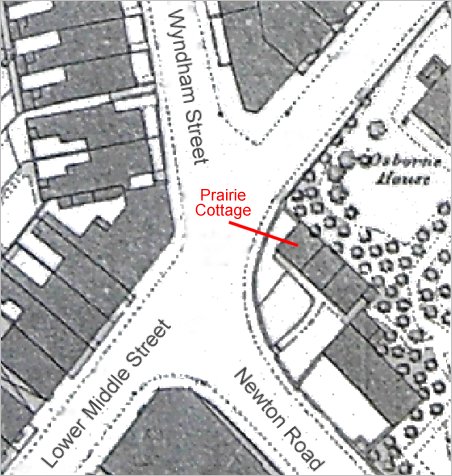
A map, based on the 1886 Ordnance Survey, showing the location of Prairie Cottage.
gallery

The entry of John Cox Chaffin's baptism of 11 October 1826 in St John's parish register.
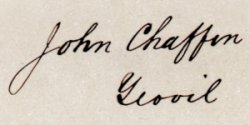
From my
collection
John Chaffin's signature from an 1862 carte de visite.
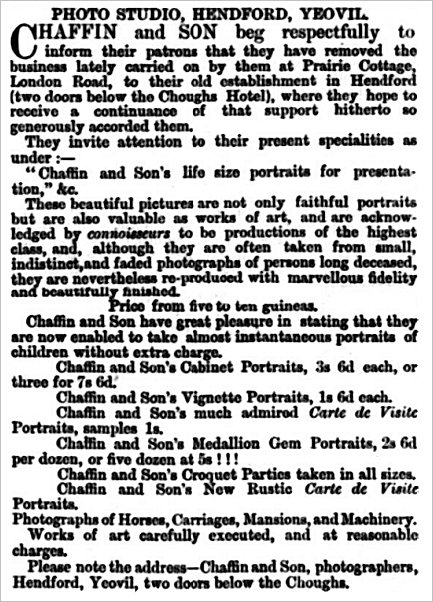
A notice placed in the 30 July 1869 edition of the Western Gazette, informing his clients that he had moved from Prairie Cottage, London Road (today's Lower Middle Street) "to their old establishment in Hendford". Prairie Cottage was opposite the Elephant and Castle - the corner house of three cottages now the site of the old Western Gazette offices - since in February 1866 it was reported in the Western Gazette "A discussion ensued regarding the condition of the corner near Prairie Cottage, London Road, where a wall had been ordered to be built."
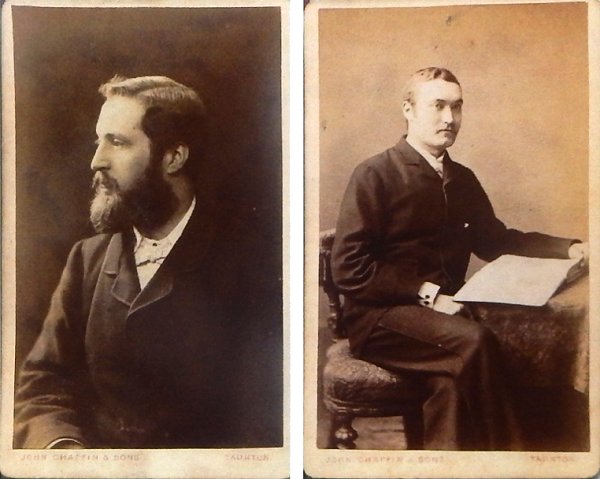
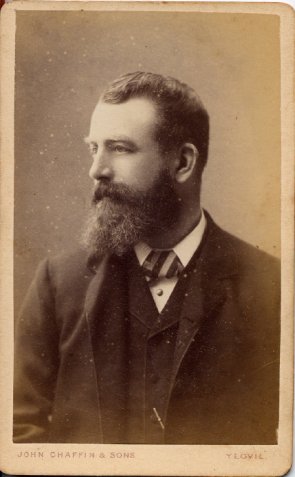 |
Cartes de visite of John Chaffin's three sons; above left is Thomas Hayward Chaffin (1849-1933) above right is Lionel Harry Chaffin (1858 - 1940) left is John Tarver Chaffin (1852 - 1919) Probably all photographed at the Taunton studio in 1878. |
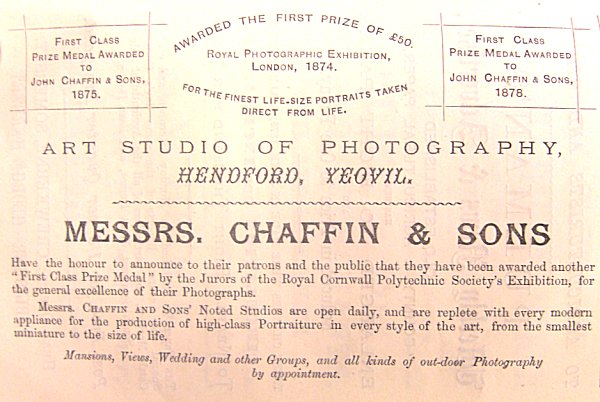
An advertisement for Chaffin & Sons of Hendford in Whitby's Yeovil Almanack Advertiser of 1879 before the business expanded to Taunton.
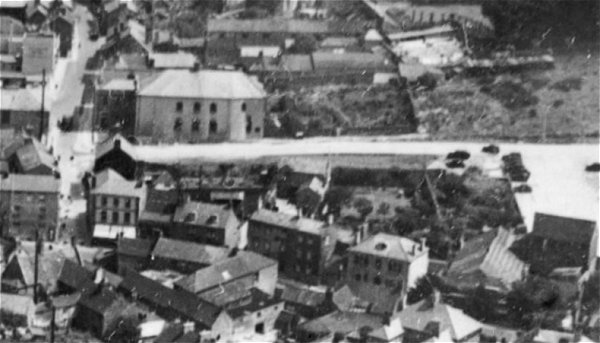
This aerial photograph dates to 1935 and shows Petters Way running across the photograph from South Street, at left, to the car park at right. Buildings of note are - the Greyhound Inn at very top left, the Baptist church at top left, the Three Choughs Hotel at centre left edge with the junction of South Street with Hendford to its right. On the opposite corner the buildings running along the east side of Hendford (with their street elevations facing us) are Chudleigh's seed merchants, the small shop that had been John Chaffin's photographic studio (later the WI Market), next to the Butcher's Arms. Next is Flower's House then Ayr Villa and finally the furniture emporium known as The Rink owned by Henry White. Note that in the top right hand corner is the field that the Yeovil Law Courts and Police Station would be built on three years later, in 1938.
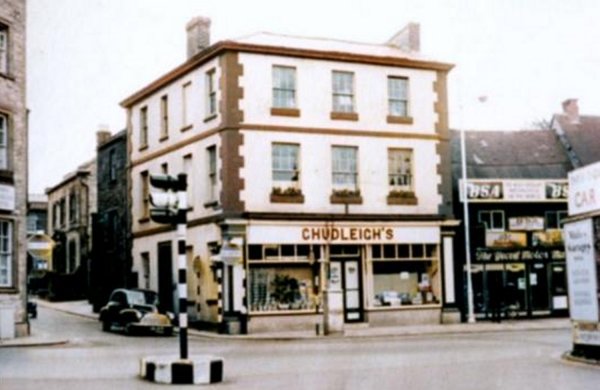
This
colourised photograph
features in my
book "Lost Yeovil"
This photograph, probably taken in the 1960's, shows narrow South Street (with the car driving out of it) was at the time. The Three Choughs Hotel is at left. Chudleigh's seed merchants, formerly the premises of seed merchant John Farley and later his son John Howe Farley, was demolished in the 1960's to widen South Street along with the building next to it (with the BSA signs) which had earlier been Chaffin's photographic studios between 1862 and 1919. At the time of this photograph it was occupied by Yeovil Motor Cycle Mart.
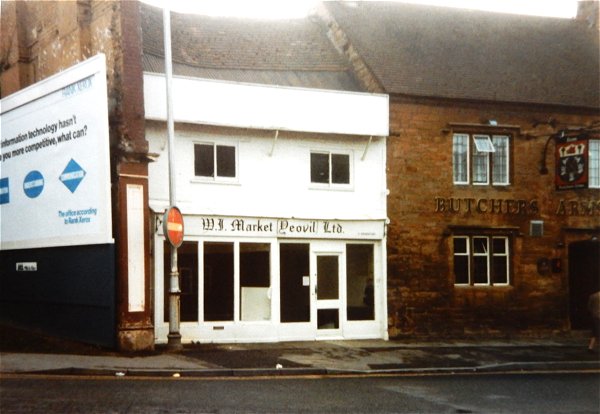
Courtesy of
Colin Haine
By the time of this 1984 photograph John Chaffin's photographic studio was occupied by the Yeovil branch of the Women's Institute. Chudleigh's premises from the previous photograph had been demolished by this time and Chaffin's former premises were to follow shortly after this photograph..
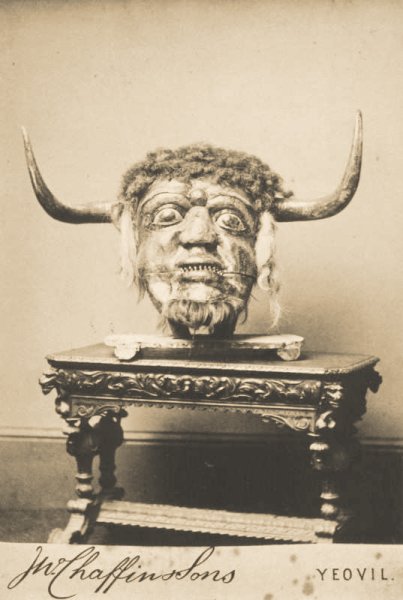
I just had to include this - the original Dorset Ooser mask photographed by John Chaffin and Sons of Yeovil, probably at their Yeovil studio at 6 Hendford, sometime between 1883 and 1891. The Dorset Ooser is an item of nineteenth century Dorset folklore, a mask that is now almost lost to this world and to this time. The grotesque mask, consisting of a human face with horns, had been owned by the Cave family of Holt Farm, Melbury Osmond, Dorset, for ‘time out of mind’. During the mid-nineteenth century, the large, horned mask was kept in the malt house in Melbury Osmond, and seems to have been viewed by many of those living in the village as an object of considerable terror and ugliness.
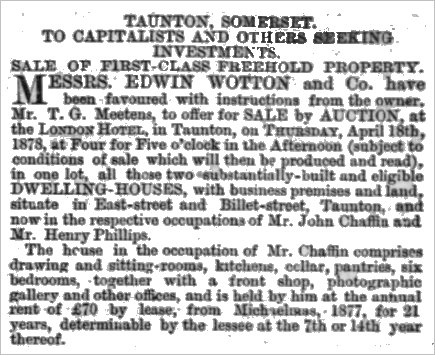
A notice from the 6 April 1878 edition of the Somerset County Gazette noting the sale of John Chaffin's Taunton studio with a good description of the property and the fact that Chaffin was paying £70 per annum for the lease.

An 1879 advertisement for Chaffin & Sons of Hendford in Whitby's Yeovil Almanack Advertiser.
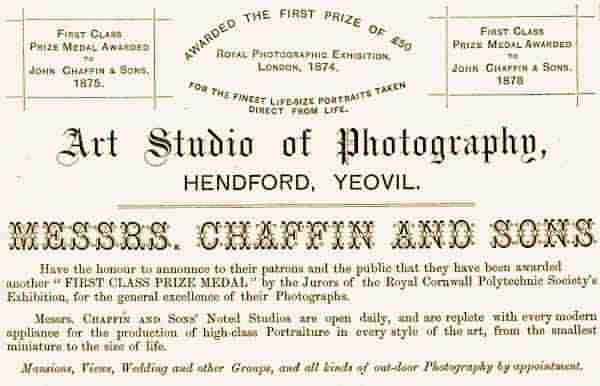
A very similar advertisement to the previous, from the 1880 edition of Whitby's Yeovil Almanack Advertiser.
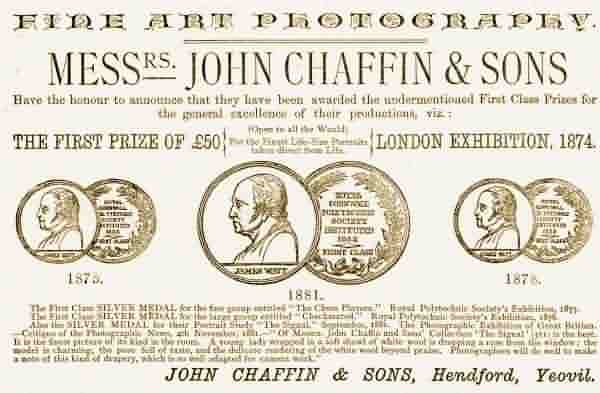
An advertisement for Chaffin & Sons of Hendford in Whitby's Yeovil Almanack Advertiser of 1882, just a few years before John Senior's death in 1885. The displays of the awards was to distinguish their excellence from their growing number of competitors.
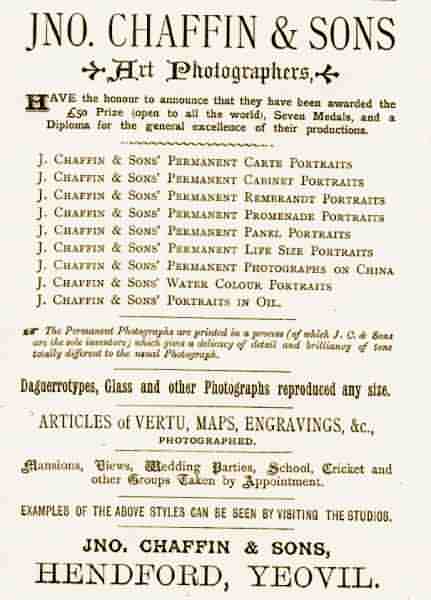
An advertisement for Chaffin & Sons of Hendford in Whitby's Yeovil Almanack Advertiser of 1888 showing their range of photographic options. This was the first time in about ten years that Chaffin & Sons claimed to be 'sole inventors' of a process producing permanent photographs with a "delicacy of detail and brilliancy of tone totally different to the usual photograph".

The entry of John Cox Chaffin's burial on 27 April 1885 from the parish register of St Mary Magdalene, Taunton.
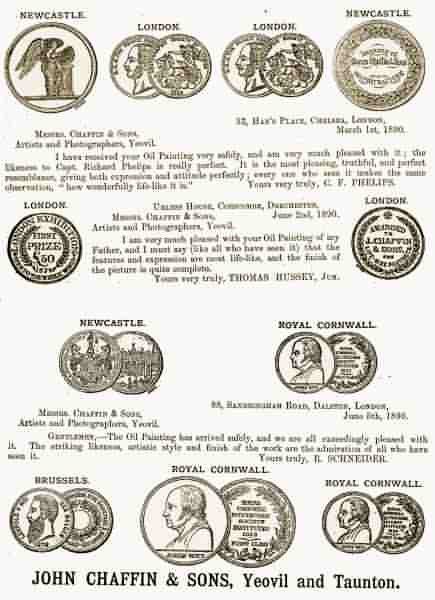
A double-page spread advertisement in Whitby's Yeovil Almanack Advertiser of 1890 clearly demonstrating that John's photographic studios were producing portraits in oil paints as well as photographs. The number of medals and prizes awarded was also growing.
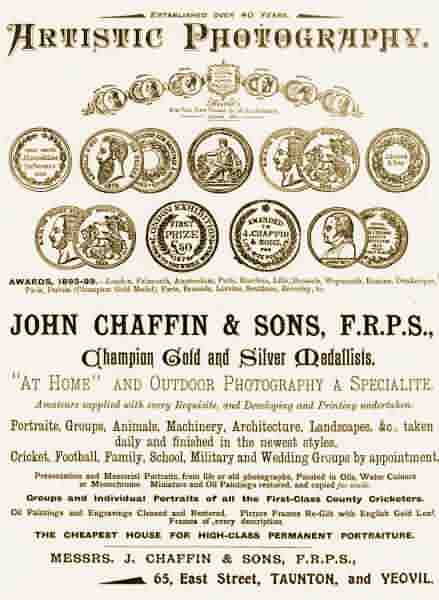
A double-page spread advertisement in Whitby's Yeovil Almanack Advertiser of 1900.
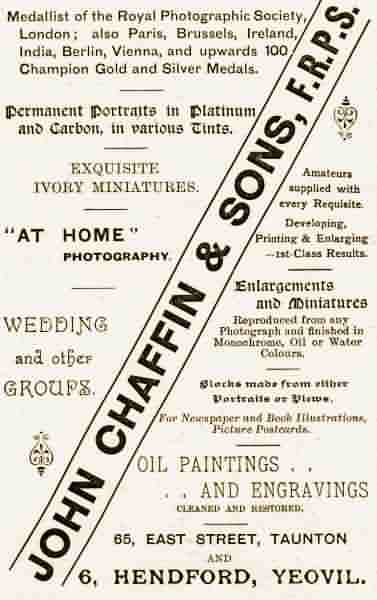
Chaffin & Sons' advertisement in Whitby's Yeovil Almanack Advertiser. This advertisement was used between 1906 and 1910.
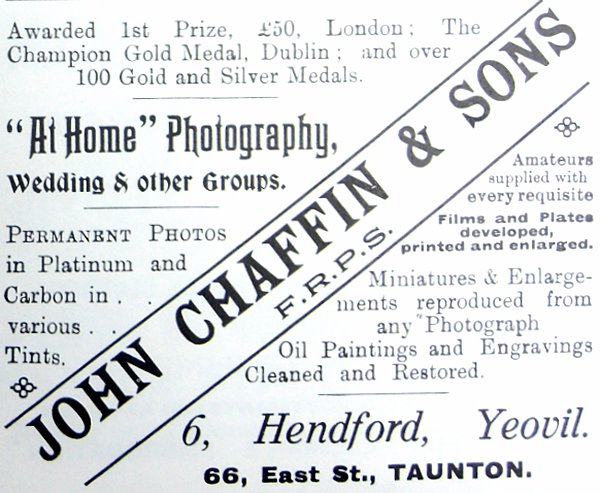
This advertisement in Whitby's Yeovil Almanack Advertiser between 1914 and 1918 and clearly the business was aiming for the home market with visiting location shoots as well as supplying cameras and other photographic equipment to amateurs.

John Chaffin & Sons were still winning international awards into the twentieth century as reported in this snippet from the Western Gazette of 17 May 1901.